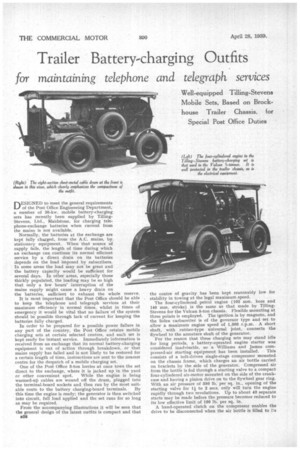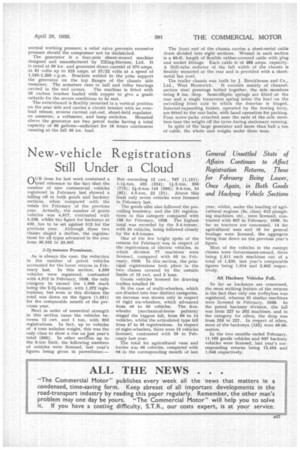Trailer Battery-charging Outfits
Page 32

Page 33

If you've noticed an error in this article please click here to report it so we can fix it.
for maintaining telephone and telegraph services
Well-equipped Tilling-Stevens Mobile Sets, Based on Brockhouse Trailer Chassis. for Special Post Office Duties DESIGNED to meet the general requirements of the Post Office Engineering Department, a number of 30-kw. mobile battery-charging sets has recently been supplied by TillingStevens, Ltd., Maidstone, for charging telephone-exchange batteries when current from the mains is not available.
Normally, the batteries at the exchange are kept fully charged, from the A.C. mains, by stationary equipment. When that source of supply fails, the length of time during which an exchange can continue its normal efficient service by a direct drain on its batteries depends on the load imposed by subscribers. In some areas the load may not be great and the battery capacity would be sufficient for several days. In other areas, especially those thickly populated, the loading may be so high that only a few hours' interruption of the mains supply might cause a heavy drain on the batteries, sufficient to exhaust the whole reserve.
It is most important that the Post Office should be able to keep the telephone and telegraph services at their maximum efficiency in normal times, whilst in times of emergency it would be vital that no failure of the system should be possible through lack of current for keeping the batteries fully charged.
In order to be prepared for a possible power failure in any part of the country, the Post Office retains mobile charging sets at certain selected centres, and each set is kept ready for instant service. Immediately information is received from an exchange that its normal battery-charging equipment is out of action through breakdown, or that mains supply has failed and is not likely to be restored for a certain length of time, instructions are sent to the nearest centre for the despatch of a mobile charging set.
One of the Post Office 3-ton lorries at once tows the set direct to the exchange, where it is jacked up in the yard or other convenient spot. While the engine is being warmed-up cables are wound off the drum, plugged into the terminal-board sockets and then run by the most suit able route to the battery charging-board terminals. By this time the engine is ready; the generator is then switched • into circuit, full load applied and the set runs for so long • as may be required.
From the accompanying illustrations it will be seen that the general design of the latest outfits is compact and that 1326 the centre of gravity has been kept reasonably low for stability in towing at the legal maximum speed. The four-cylindered petrol engine (102 mm. bore and 140 mm. stroke) is the same as that made by TiltingStevens for the Vulcan 5-ton chassis. Flexible mounting at three points is employed. The ignition is by magneto, and the Solex carburetter is of the governor type and set to allow a maximum engine speed of 1,300 r.p.m. A short shaft, with rubber-type universal joint, connects the flywheel to the armature shaft of the generator. For the reason that these charging sets may stand idle for long periods, a battery-operated engine starter was considered inadvisable, so a Williams and James com pressed-air starting equipment has been installed. This consists of a belt-driven single-stage compressor mounted on the chassis frame, which charges an air bottle carried on brackets by the side of the generator. Compressed air from the bottle is fed through a starting valve to a compact four-cylindered air-motor mounted on the side of the crankcase and having a pinion drive on to the flywheel gear ring. With an air pressure of 350 lb. per sq. in., opening of the starting valve for 1J to 2 secs. only will turn the engine rapidly through two revolutions. Up to about 40 separate starts may be made before the pressure becomes reduced to its low effective limit of 150 lb. per sq. in.
A hand-operated clutch on the compressor enables the drive to be disconnected when the air bottle is filled to its normal working pressure; a relief valve prevents excessive pressure should the compressor not be declutched.
The generator is a four-pole shunt-wound machine designed and manufactured by Tilling-Stevens, Ltd. It is rated at 30 kw. and generates direct current of 370 amps. at 81 volts up to 525 amps. at 57/22 volts at a speed of 1,240-1,260 r.p.m. Brackets welded to the yoke support the generator on the top flanges of the chassis side members. The armature runs in ball and roller bearings carried in the end covers. The machine is fitted with 20 carbon brushes loaded with copper to give a grade suitable for the severe conditions to be met.
The switchboard is flexibly mounted in a vertical position on the near side and carries a circuit breaker with an overload release, reverse current cut-out, shunt-field regulator, an ammeter, a voltmeter, and lamp switches. Mounted above the generator are two petrol tanks having a total capacity of 60 gallons—sufficient for 16 hours continuous running at the full 30 kw. load. The front end of the chassis carries a sheet-metal cable drum divided into eight sections. Wound in each section is a 60-ft. length of flexible rubber-covered cable with plug and socket fittings. Each cable is of 288 amps. capacity. A Still-tube radiator of the full width of the chassis is flexibly mounted at the rear and is provided with a sheetmetal fan cowl.
The trailer chassis was built by J. Brockhouse and Co.,
Ltd., West Bromwich. It consists mainly of channelsection steel pressings bolted together, the side members being 8 ins. deep. Semi-elliptic springs are fitted at the rear and a single transverse spring takes the load on the swivelling front axle to which the drawbar is hinged. Internal-expanding brakes, operated by the towing lorry, are frtted to the rear hubs, with hand operation for parking. Four screw-jacks attached near the ends of the side members take the weight off the tyres during stationary running.
In spite of the large generator and more than half a ton of cable, the whole unit weighs under three tons.












































































